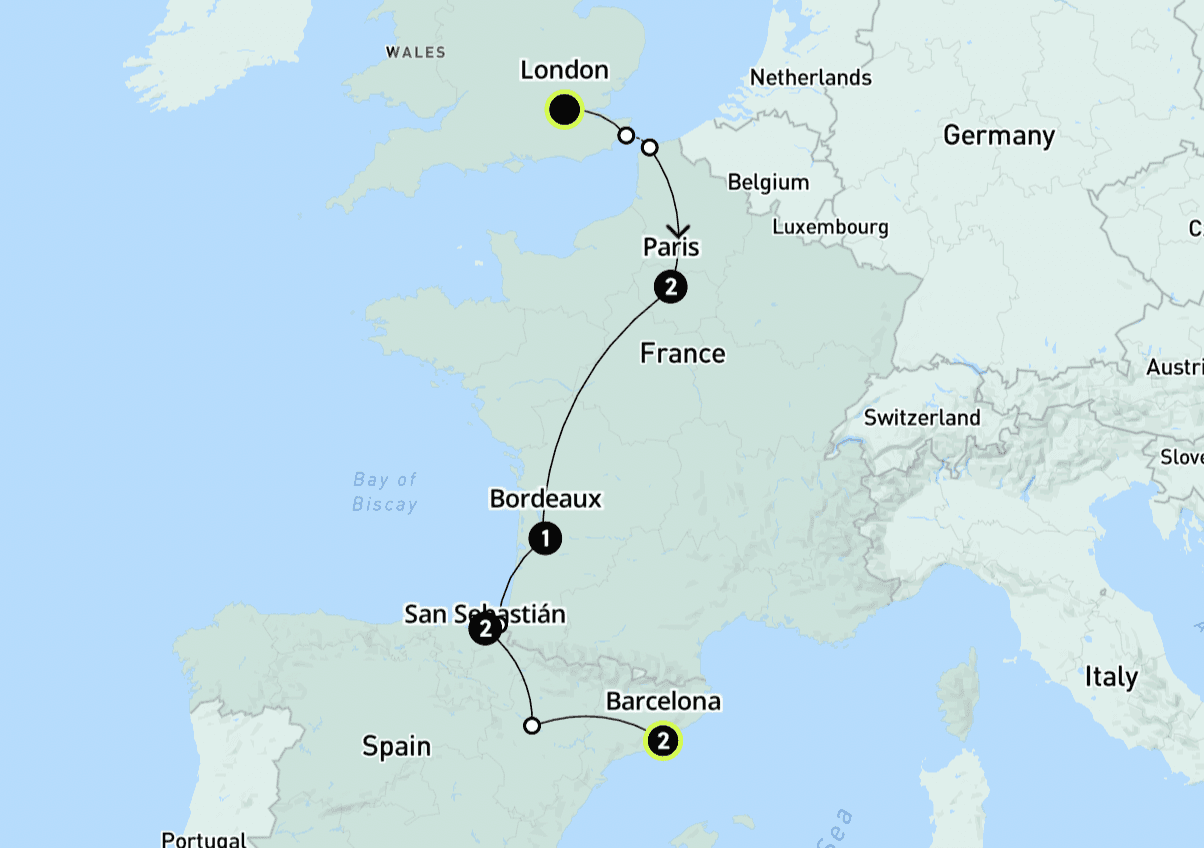Thinking about Spain? Let me tell you—train travel here is the way to go!
From the super-fast AVE to jaw-dropping scenic routes, Spain’s trains connect you to iconic cities and hidden gems effortlessly.
Stick with me, and I’ll help you plan an amazing journey you’ll never forget!

Spain’s train system is more than just a way to get from one city to another—it’s an opportunity to immerse yourself in the country's rich culture, breathtaking landscapes, and efficient infrastructure. For UK travelers, accustomed to the convenience of train travel at home, Spain’s rail network offers a familiar yet extraordinary experience. From high-speed journeys connecting world-famous cities to regional lines that wind through picturesque villages, this guide will answer every question you might have. Prepare to navigate Spain’s trains like a pro, save time and money, and enjoy unique adventures along the way.
An Overview of Spain’s Train System
Spain’s rail network stands out as one of the best in Europe, celebrated for its speed, reliability, and eco-friendly design. With connections spanning cities, towns, and regions, it caters to tourists, commuters, and locals alike. Whether you’re exploring cosmopolitan hubs or rural gems, the Spanish train system makes travel seamless.
Operator Overview: The Spanish train system is primarily operated by Renfe, the national rail company. Renfe manages a variety of services, from high-speed AVE trains to regional and commuter lines, offering a consistent and reliable experience. Travelers will also encounter a few regional operators, like Euskotren in the Basque Country, but Renfe covers most routes.
High-Speed AVE Network: The AVE (Alta Velocidad Española) is Spain’s crown jewel, boasting speeds up to 310 km/h. These trains link cities such as Madrid, Barcelona, Seville, and Valencia in record time, making long-distance travel a breeze. They rival flights in convenience and comfort, often leaving travelers with more time to explore.
Regional Trains: Ideal for those seeking to discover smaller towns or rural areas, regional trains offer a slower but often more scenic way to travel. While they may not have the luxury of AVE services, they provide a more authentic experience of Spain.
Cercanías: These commuter trains serve urban and suburban areas, connecting city centers with surrounding neighborhoods. Perfect for navigating sprawling cities like Madrid or Barcelona, Cercanías trains are affordable and frequent, ensuring locals and tourists alike can get where they need to go.
Sustainability: Trains in Spain are also an eco-friendly alternative to driving or flying. Powered by electricity and often sourced from renewable energy, the train network helps reduce your carbon footprint while providing efficient travel options.

Types of Trains in Spain
Understanding the types of trains available in Spain helps ensure you choose the right one for your trip. Whether you’re looking for speed, comfort, or affordability, Spain’s diverse rail options have you covered.
AVE Trains: These are Spain’s high-speed, long-distance trains designed for comfort and efficiency. AVE services typically include spacious seats, power outlets, Wi-Fi, and dining cars. They’re perfect for routes like Madrid to Barcelona or Seville to Valencia, where speed is a priority. Travelers often compare the AVE to flying but with less hassle and more legroom.
ALVIA Trains: Blending high-speed service with regional connectivity, ALVIA trains offer versatility. They can switch between high-speed and conventional tracks, making them ideal for routes that combine large cities with smaller towns. For example, the route from Madrid to Gijón offers a mix of speed and scenic charm.
Regional Express Trains: Slower and more budget-friendly, these trains connect Spain’s smaller towns and rural areas. They’re perfect for travelers who want to take their time and explore less touristy destinations, such as the Costa Brava or Extremadura.
Luxury Trains: Spain also offers unique luxury train experiences, such as El Transcantábrico or the Tren Al-Andalus. These trains feature private suites, gourmet dining, and curated tours, transforming your journey into a high-end vacation.
Overnight Trains: While less common than in other European countries, Spain does have night trains for select routes, such as Madrid to Lisbon. These trains are an economical option for long-distance travel, allowing you to wake up refreshed in a new city.
Train travel is just one way to make your journey easier—here are 10 more travel hacks to enhance your trip.
How to Buy Train Tickets in Spain
Booking train tickets in Spain is easier than you might think, but knowing the options can help you save both time and money. From flexible multi-ride passes to discounts for early bookings, there’s a ticket to suit every travel plan.
Online Booking: Platforms like Renfe’s official website and Trainline are the most convenient ways to purchase tickets. Both support English and offer digital tickets that can be stored on your phone, eliminating the need to print them.
Renfe Spain Pass: This pass is specifically designed for tourists and offers unlimited train travel over a set number of days. It’s a great option if you’re planning a multi-city itinerary, such as Madrid, Barcelona, and Seville.
Early-Bird Discounts: Renfe often releases discounted fares weeks in advance, so booking early can result in significant savings. These tickets, however, are usually non-refundable, so plan carefully.
Ticket Classes: Spanish trains offer several ticket classes, including Turista (economy), Turista Plus (premium economy), and Preferente (first class). First-class options often include perks like meals and access to station lounges.
Station Purchases: Tickets can also be bought at train stations, either at staffed ticket counters or self-service machines. However, during peak travel times, queues can be long, so online booking is often a better choice.
If you find yourself near Barcelona Sants station, take a short detour to experience some of the city's finest coffee spots; our list of 17 Must-Visit Coffee Shops in Barcelona: Hidden Gems & Local Favorites will point you in the right direction.

Key:
🚄 Yellow (High-Speed AVE Trains)
These are Spain’s fastest and most luxurious trains, connecting cities like Madrid, Barcelona, and Seville at speeds of up to 310 km/h. Perfect for long-distance travel when you want speed and comfort.
🚋 Red (Normal Service Trains)
Slower regional and commuter trains are affordable and perfect for exploring smaller towns or traveling shorter distances. They give you a closer look at Spain’s countryside and local culture.
Must-Try Train Routes in Spain
Spain’s train routes aren’t just practical—they’re iconic. From high-speed connections between major cities to scenic regional rides, each route offers a unique way to experience the country.
Madrid to Barcelona (AVE): One of Spain’s most popular routes, this AVE journey covers 621 km in just under three hours. The sleek trains and city-center-to-city-center convenience make it a favorite for both business and leisure travelers.
Seville to Granada: This Andalusian route offers a picturesque ride through rolling hills and olive groves, ending in the historic city of Granada, home to the world-famous Alhambra Palace.
Bilbao to San Sebastián: A short but spectacular coastal route, this journey provides stunning views of the Bay of Biscay and easy access to two of Spain’s most vibrant cities in the Basque Country.
Madrid to Toledo: Just a 30-minute ride, this route is perfect for a day trip to explore Toledo’s medieval streets, iconic cathedral, and historic landmarks.
Ronda to Algeciras: This slower regional train ride takes you through the dramatic landscapes of Andalusia’s Sierra de Grazalema. Expect rugged cliffs, lush valleys, and picture-perfect white villages.
Scenic Train Journeys for the Bucket List
Some journeys aren’t just about getting somewhere—they’re the experience itself. Spain is home to stunning train routes that will have you reaching for your camera (and your Instagram). These scenic rides offer breathtaking views and unforgettable moments, perfect for impressing your friends and family with unique travel stories.
El Transcantábrico: This luxury train winds along northern Spain’s coast, combining historic charm with views of the Bay of Biscay. The route includes stops in places like Santiago de Compostela, famous for its cathedral and pilgrimage history. Ideal for travelers who love indulgence with a side of culture.
Costa Brava Route: Known for turquoise waters and cliffside views, this journey is all about Mediterranean beauty. It’s the perfect choice if you’re craving sea breezes and postcard-worthy scenery.
Ronda to Algeciras: You’ll travel through Andalusia’s rugged mountains and whitewashed villages, offering moments that feel like they belong in a storybook. This slower-paced route is a photographer’s dream.
Madrid to Segovia: In just 30 minutes, this journey takes you from the bustling capital to a charming UNESCO World Heritage site with its iconic aqueduct and fairytale-like Alcázar.
Pyrenees Explorer: Take local trains into the heart of the Pyrenees, where quaint villages and stunning natural parks await. If you’re looking to slow down and connect with nature, this route is a must.

Navigating Train Stations Like a Local
Spain’s train stations are lively hubs filled with energy, but they can be overwhelming if you’re not prepared. The good news? With these tips, you’ll breeze through like a pro, avoiding crowds and making the most of your travel time.
Arrive Early: For high-speed AVE trains, security checks are similar to airports, so plan to arrive at least 30 minutes ahead. For regional and commuter trains, 15 minutes is usually fine.
Look for “Andén” Signs: Andén means platform in Spanish. Stations like Madrid Atocha and Barcelona Sants are large, so follow the signs carefully to avoid missing your train.
First-Class Perks: If you’ve booked Preferente (first class), take advantage of station lounges. These quieter areas offer free snacks, drinks, and Wi-Fi, perfect for unwinding before your trip.
Baggage Storage: Many stations offer lockers or left-luggage services, which are lifesavers if you’re stopping over for a few hours to explore.
Accessibility: Stations are designed to be accessible, with ramps, elevators, and staff available to help. If you need assistance, don’t hesitate to ask—it’s part of the Spanish hospitality.

Accessibility, Comfort, and Onboard Amenities
Let’s talk about what it’s like on the trains themselves. Whether you’re after comfort, convenience, or inclusivity, Spain’s rail services deliver. From accessible features to amenities like Wi-Fi and dining cars, your journey will be as enjoyable as your destination.
Wheelchair Access: Renfe trains have ramps, elevators, and designated wheelchair spaces, making travel easy for everyone. Stations also have accessible ticket counters and waiting areas.
Wi-Fi and Charging Points: Most AVE trains offer free Wi-Fi and power outlets at every seat, perfect for streaming your favorite show or updating your social media.
Dining Options: First-class passengers often enjoy complimentary meals, but dining cars and vending machines are available to everyone. Bring your favorite snacks for a more personal touch!
Seating Choices: Whether you’re in Turista or Preferente class, seats are designed for comfort with ample legroom. Preferente often includes reclining seats and extra space—great for long journeys.
Luggage Allowance: Each passenger can bring three pieces of luggage, making it easier to pack all your outfits for those Instagram-perfect photoshoots.
Travel Etiquette and Insider Tips
Knowing a bit about Spanish train culture can make your journey smoother and more enjoyable. These practical tips will help you blend in with locals and avoid common pitfalls.
Respect Quiet Zones: Some trains have designated quiet cars, marked as “zona silenciosa.” These are perfect for relaxing but come with strict no-talking and no-phone rules.
Arrive Punctually: Spanish trains are famously on time, so don’t risk missing yours by cutting it close. Arriving early means less stress and more time to soak in the atmosphere.
Pack Light: While luggage racks are available, packing light makes navigating train stations and tight spaces much easier. You’ll thank yourself later.
Practice Politeness: A simple “por favor” (please) or “gracias” (thank you) goes a long way when interacting with train staff or fellow passengers.
Watch Your Belongings: While Spain is generally safe, train stations can attract pickpockets. Keep your bags close and avoid leaving valuables unattended.

Why Train Travel in Spain is Perfect for UK Travelers
Spain’s trains aren’t just practical—they’re a reflection of the freedom, comfort, and cultural richness UK travelers crave. Here’s why the Spanish rail system feels like it was made for you.
Familiarity Meets Adventure: Like UK trains, Spain’s system is easy to navigate but opens up a world of new experiences. Think of it as the perfect mix of comfort and discovery.
No Language Barrier Worries: Many stations and train staff cater to English speakers, and digital resources like apps make it even easier to plan your journey.
Save Time, Gain Freedom: High-speed trains rival flights in efficiency, taking you straight into city centers without the hassle of airports or rental cars.
Affordable Luxury: With early-bird discounts and affordable regional options, you can experience first-class perks without breaking the bank.
Cultural Exploration: Trains allow you to experience Spain’s diverse regions up close, from cosmopolitan cities to hidden countryside gems, all at your own pace.
Cheap Flights to Spain – If train travel isn’t your style, check out this guide on finding budget-friendly flights to Spain.
Your Perfect Spanish Train Adventure Awaits
Spain’s train system is more than just a way to get around—it’s a way to enhance your travel experience. Whether you’re chasing high-speed thrills on the AVE or soaking in the scenery on regional routes, Spain’s trains offer something for everyone. With this guide in hand, you’re ready to embrace the freedom and adventure of Spanish rail travel while impressing your friends and family with unforgettable stories and photos.
Ready to explore Spain by train? Share your favorite routes or tips in the comments below. If you found this guide helpful, pass it along to your travel-loving friends and start planning your Spanish rail adventure today!
FAQS Travel to Paradiso
Recent Posts
















